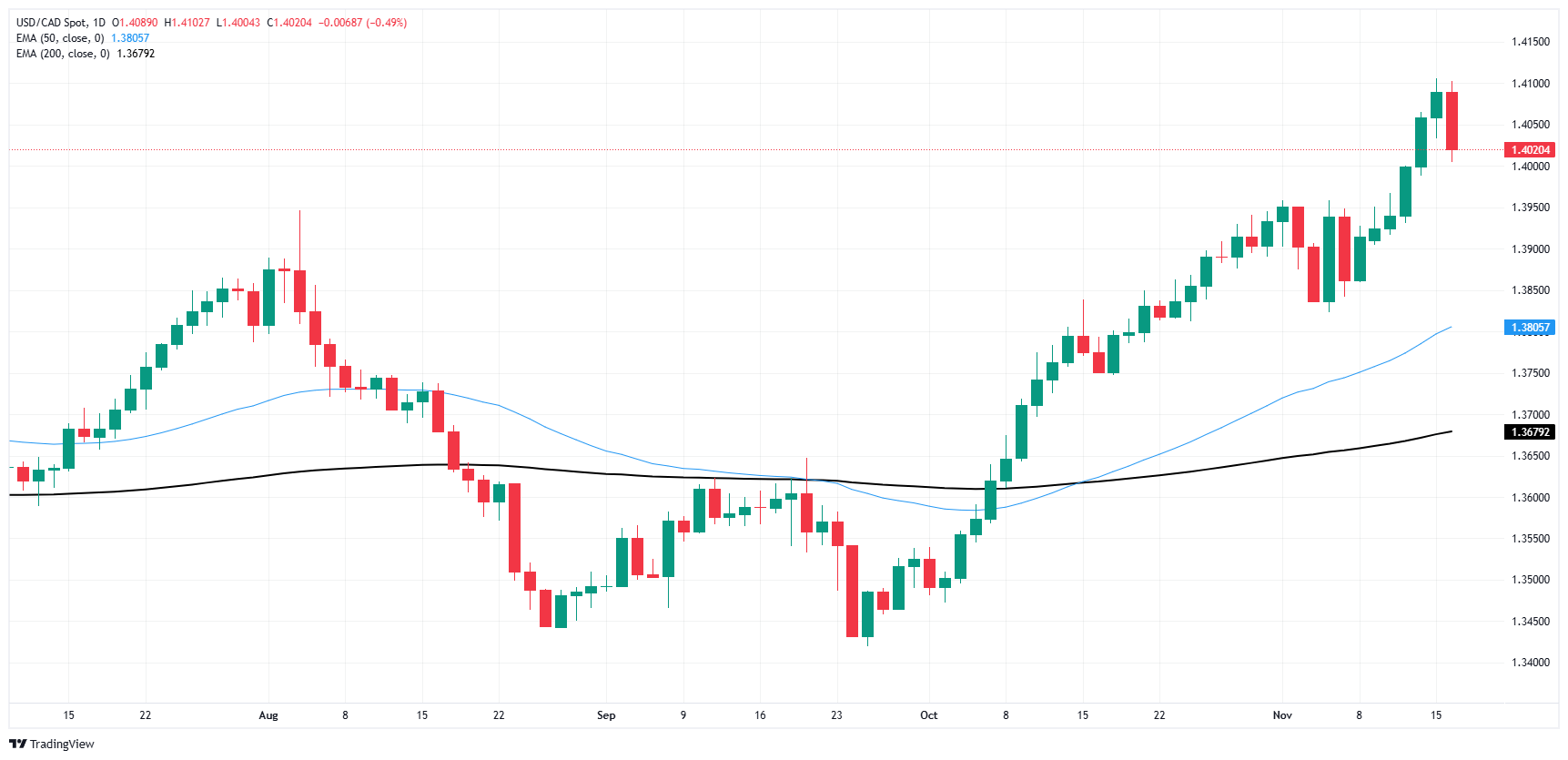- The Canadian Dollar caught a brief reprieve from steady selling pressure.
- Canada delivers CPI inflation figures this week, ending a data dry spell.
- The CAD still remains deeply discounted against the Greenback.
The Canadian Dollar (CAD) tiled into the bullish side for the first time in over a week on Monday, kicking off the trading week’s chart action with a meager bullish recovery against the Greenback. Market flows are less about bidding up the Loonie than they are taking a breather from one-sided US Dollar buying, and sustained recovery momentum is unlikely to build underneath the CAD’s tattered wings.
Canada is set to release its first batch of impactful economic data in over a week on Tuesday. Headline Canadian Consumer Price Index (CPI) inflation figures for October are expected to accelerate on an annualized basis. The Bank of Canada (BoC) will also be releasing it’s own special version of Canadian CPI, but markets are struggling to nail down a forecast for the CPI metric.
Daily digest market movers: Canadian Dollar gets reprieve from Greenback strength
- The Canadian Dollar recovered half of a percent against the Greenback as the Loonie struggles to pare back ground from multi-year lows.
- Canadian CPI inflation figures are due on Tuesday. Headline CPI inflation for the year ended in October is expected to accelerate to 1.9% YoY from 1.6%. October’s monthly CPI inflation print is expected to swing back to 0.3% after the previous month’s -0.4% contraction.
- USD data remains on the tepid side this week, giving markets a much-needed break from US-centric economic data releases.
- A smattering of Federal Reserve (Fed) officials making appearance this week could throw a wrench in the works. Fedspeak has drifted toward the cautious side in recent weeks.
- Canadian Retail Sales for September also loom ahead at the end of the week on Friday.
Canadian Dollar price forecast
The Canadian Dollar (CAD) is drifting back into the bullish side against the US Dollar on Monday. However, the Loonie has found itself at the bottom of a very long hole after falling to multi-year lows against the Greenback and sending USD/CAD to 54-month highs late last week.
A slight paring of the pair’s recent peaks is unlikely to spark a sustained move, so bears should be ready to wave goodbye to the prospect of a sustained move lower back into the 200-day Exponential Moving Average (EMA) near 1.3675.
USD/CAD daily chart
Canadian Dollar FAQs
The key factors driving the Canadian Dollar (CAD) are the level of interest rates set by the Bank of Canada (BoC), the price of Oil, Canada’s largest export, the health of its economy, inflation and the Trade Balance, which is the difference between the value of Canada’s exports versus its imports. Other factors include market sentiment – whether investors are taking on more risky assets (risk-on) or seeking safe-havens (risk-off) – with risk-on being CAD-positive. As its largest trading partner, the health of the US economy is also a key factor influencing the Canadian Dollar.
The Bank of Canada (BoC) has a significant influence on the Canadian Dollar by setting the level of interest rates that banks can lend to one another. This influences the level of interest rates for everyone. The main goal of the BoC is to maintain inflation at 1-3% by adjusting interest rates up or down. Relatively higher interest rates tend to be positive for the CAD. The Bank of Canada can also use quantitative easing and tightening to influence credit conditions, with the former CAD-negative and the latter CAD-positive.
The price of Oil is a key factor impacting the value of the Canadian Dollar. Petroleum is Canada’s biggest export, so Oil price tends to have an immediate impact on the CAD value. Generally, if Oil price rises CAD also goes up, as aggregate demand for the currency increases. The opposite is the case if the price of Oil falls. Higher Oil prices also tend to result in a greater likelihood of a positive Trade Balance, which is also supportive of the CAD.
While inflation had always traditionally been thought of as a negative factor for a currency since it lowers the value of money, the opposite has actually been the case in modern times with the relaxation of cross-border capital controls. Higher inflation tends to lead central banks to put up interest rates which attracts more capital inflows from global investors seeking a lucrative place to keep their money. This increases demand for the local currency, which in Canada’s case is the Canadian Dollar.
Macroeconomic data releases gauge the health of the economy and can have an impact on the Canadian Dollar. Indicators such as GDP, Manufacturing and Services PMIs, employment, and consumer sentiment surveys can all influence the direction of the CAD. A strong economy is good for the Canadian Dollar. Not only does it attract more foreign investment but it may encourage the Bank of Canada to put up interest rates, leading to a stronger currency. If economic data is weak, however, the CAD is likely to fall.
Information on these pages contains forward-looking statements that involve risks and uncertainties. Markets and instruments profiled on this page are for informational purposes only and should not in any way come across as a recommendation to buy or sell in these assets. You should do your own thorough research before making any investment decisions. FXStreet does not in any way guarantee that this information is free from mistakes, errors, or material misstatements. It also does not guarantee that this information is of a timely nature. Investing in Open Markets involves a great deal of risk, including the loss of all or a portion of your investment, as well as emotional distress. All risks, losses and costs associated with investing, including total loss of principal, are your responsibility. The views and opinions expressed in this article are those of the authors and do not necessarily reflect the official policy or position of FXStreet nor its advertisers. The author will not be held responsible for information that is found at the end of links posted on this page.
If not otherwise explicitly mentioned in the body of the article, at the time of writing, the author has no position in any stock mentioned in this article and no business relationship with any company mentioned. The author has not received compensation for writing this article, other than from FXStreet.
FXStreet and the author do not provide personalized recommendations. The author makes no representations as to the accuracy, completeness, or suitability of this information. FXStreet and the author will not be liable for any errors, omissions or any losses, injuries or damages arising from this information and its display or use. Errors and omissions excepted.
The author and FXStreet are not registered investment advisors and nothing in this article is intended to be investment advice.
Recommended content
Editors’ Picks

EUR/USD retargets 1.0500 on extra Dollar weakness
The selling pressure around the US Dollar picks up pace and lifts EUR/USD to the area of two-day peaks near the 1.0480 level amid declining US and German yields.

Gold sets new record-high above $2,950
Gold retreats slightly but remains within a touching distance of the record-high it set above $2,950 in the European session on Thursday. Retreating US Treasury bond yields and the risk-averse market environment help XAU/USD hold its ground.

GBP/USD holds ground above 1.2600 after US data
GBP/USD stays in positive territory above 1.2600 on Thursday, supported by a sustained US Dollar weakness following the disappointing Jobless Claims data. The cautious market mood, however, seems to be limiting the pair's upside in the near term.

Bitcoin consolidation continues as market prepares for the next major move
Bitcoin has been consolidating between $94,000 and $100,000 since February 5. Glassnode reports weakening capital inflows and declining derivatives activity, with short-term holder accumulation resembling challenging market conditions.

Money market outlook 2025: Trends and dynamics in the Eurozone, US, and UK
We delve into the world of money market funds. Distinct dynamics are at play in the US, eurozone, and UK. In the US, repo rates are more attractive, and bills are expected to appreciate. It's also worth noting that the Fed might cut rates more than anticipated, similar to the UK. In the eurozone, unsecured rates remain elevated.

The Best brokers to trade EUR/USD
SPONSORED Discover the top brokers for trading EUR/USD in 2025. Our list features brokers with competitive spreads, fast execution, and powerful platforms. Whether you're a beginner or an expert, find the right partner to navigate the dynamic Forex market.